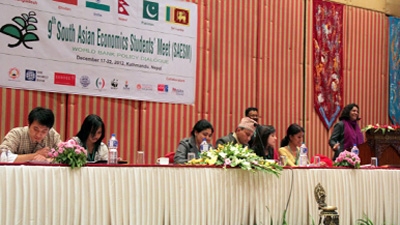December 24, 2012: While South Asia is among the most densely populated regions in the world, it is also one of the least urbanized. As rural-to-urban migration increases in South Asia, its cities across all countries increasingly face development stresses in terms of congestion, pollution, and quality-of-life issues.
In the spirit of the theme of Towards a Green South Asia at the ninth South Asia Economic Students’ Meet (SAESM) held in Nepal last week, as well as in preparation for the upcoming 2014 World Bank regional flagship on urbanization, the World Bank asked the emerging economists from Bangladesh, Bhutan, India, Nepal, Pakistan, and Sri Lanka to share their ideas about how they envision green growth in South Asian cities of the future through a writing competition.
Tahseen Sayed, Country Manager for Nepal, kicked off the session and shared thoughts about regional key initiatives and listened to the innovative ideas of youth. “As students of economics today and future leaders tomorrow, you will help shape policies and attitudes,” Sayed said. "This forum is part of our own learning. We’re very keen to listen to your fresh perspectives and thank you for your participation.”
Dr. Deb Kusum Das from Ramjas College at the University of Delhi created a framework for the budding economists to help organize their thoughts around sustainable urbanization. He asked the audience whether developing countries can have green growth. Is green growth necessary for development? And how do we define quality of life?
In response to these questions, the students shared fresh perspectives on what it will take to realize the vision of green South Asia cities of the future.

